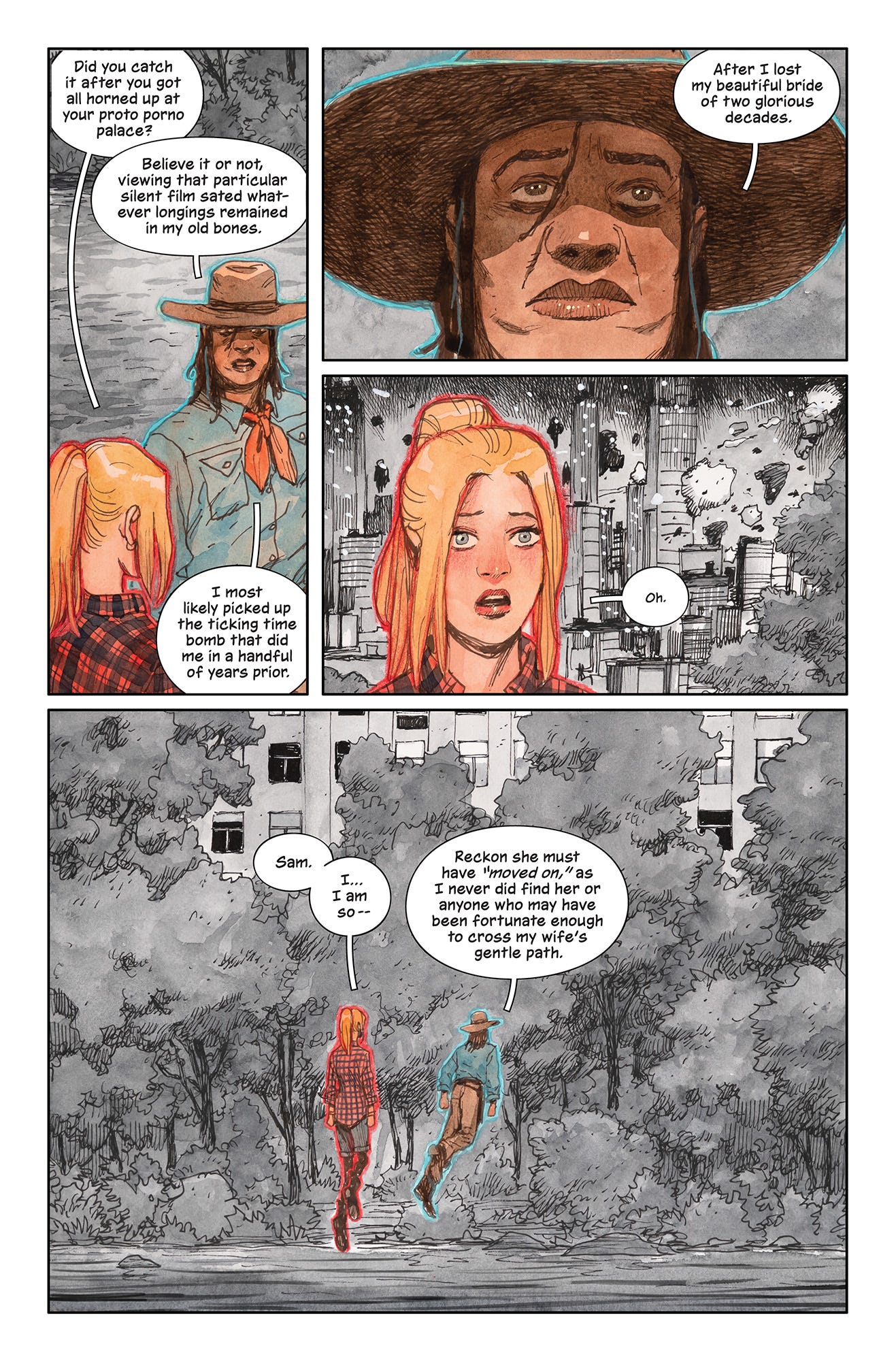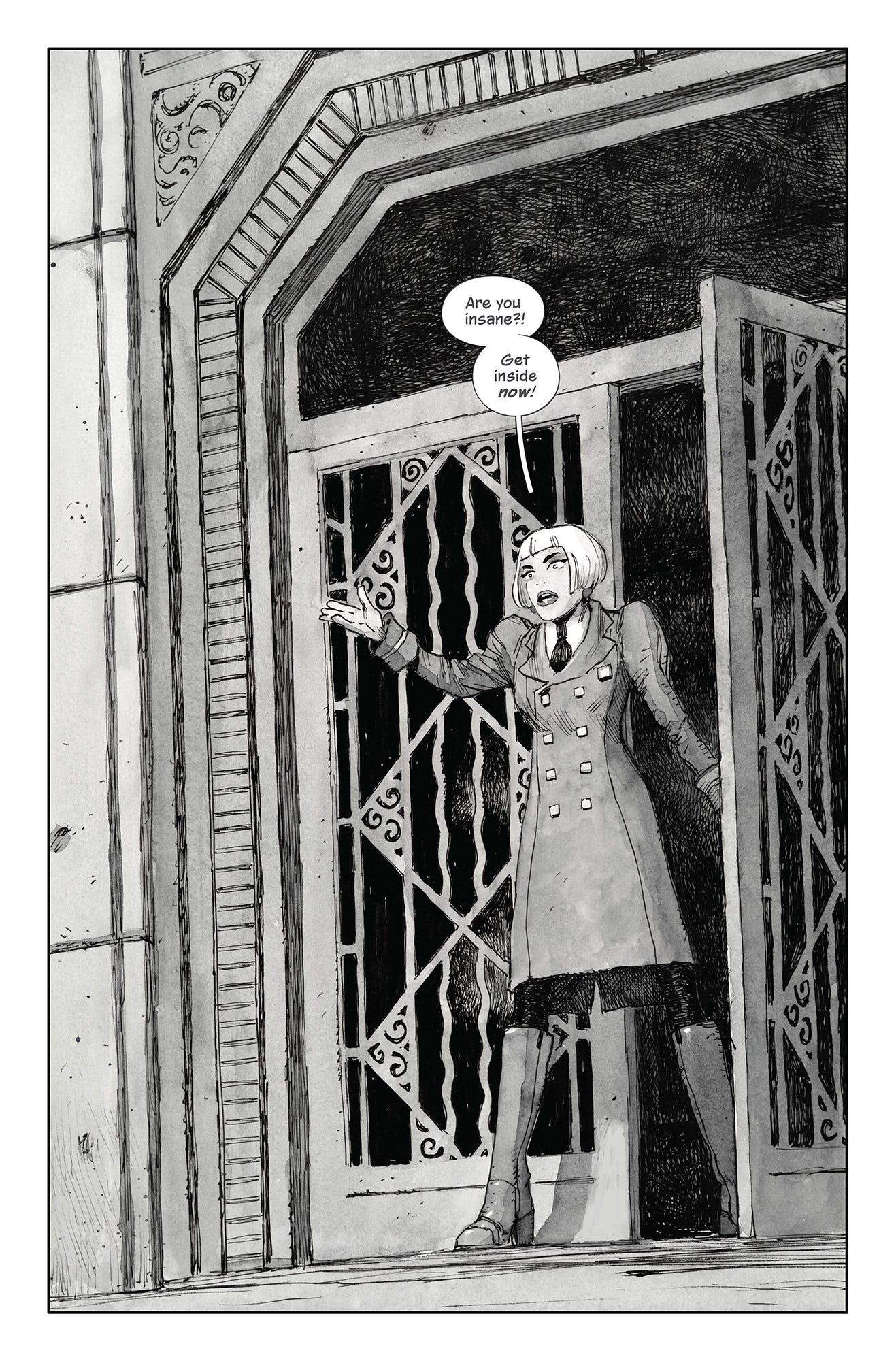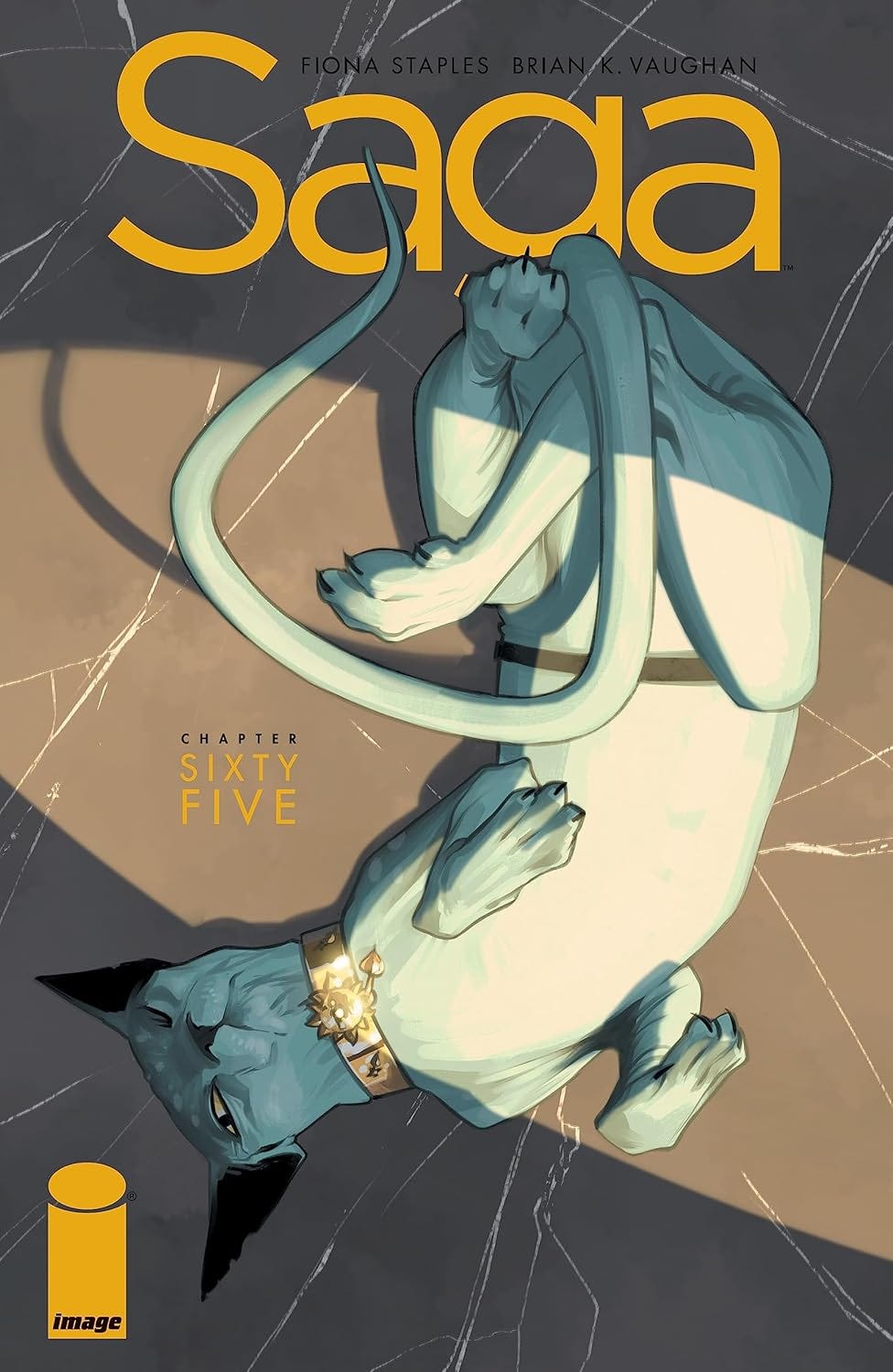Should I take this ornamentation I just stumbled across in the woods as some kind of warning?
Brian here, back on my Highly Classified Mission deep within the Canadian wilderness, briefly emerging to find a cellular signal so I finally can blast out today’s missive (sorry for the wait). If you don’t hear from me again next Monday evening, please alert the Mounties.
For now, I hope you enjoy these stunning new pages of Spectators from artist/co-creator Niko Henrichon and letterer Fonografiks, as our ghostly protagonist Sam tells his fellow voyeuristic specter Val how he contracted the unfortunate case of syphilis that led to his demise.
How does the El Dorado’s intriguing doorwoman fit into our story’s final act? Stay tuned, true beleaguers.
After more than 275 pages (!), Niko’s extraordinary hand-painted artwork continues to blow me away every damn week. As always, I hope you enjoy today’s pages—especially that gigantic double-page spread—on the biggest and brightest screen you’ve got. Your dumb phone will never do it justice!
Some of Niko’s original Spectators pages are still available for purchase over at Essential Sequential, and he’ll also be giving away a few more of these invaluable masterpieces to a couple lucky generous paid subscribers in The Tower over our several remaining months together, in case you needed another reason to finally join your fellow giraffes.
In last week’s discussion with you Tower types, we were talking about deaths of fictional characters that hit us hardest, especially as younger spectators.
There was a lot of love/heartbreak for the loss of [various spoilers redacted] in Up, Serenity, The NeverEnding Story, and especially that one episode of Futurama, but only one commenter could be selected to receive a signed copy of Saga #65 (the full script to which is still available in last week’s post, exclusively for you paid subscribers)…
…and our stoic intern Genesis the Exploded Giraffe randomly selected this surprising entry from reader/writer Cornelius Fortune:
Since I am very late coming to this particular party, I will make my entry as brief and unambiguous as possible: the death of [ancient spoiler redacted] in the hit ‘80s anime show, Robotech. It wasn’t that I was attached to the character (I liked him well enough, mind you), but his death immediately sent a flashing red signal to my 10-year-old brain that there could be a “point of no return,” vis-à-vis how even cartoon escapism could, with the right storytelling apparatus, imitate life. The family-friendly television I was raised on went to painstaking lengths not to show death, or to have any real stakes. (I seem to remember people clambering out of wrecked vehicles on action shows such as The A-Team and Airwolf, completely unscathed despite a fall from a great height). But even if a main character died in prime time on a live action show, cartoons were not supposed to do that.
XXX’s death was a catalyst to push our hero, Rick Hunter, to levels of heroism he never would have experienced otherwise. It also meant that upon tuning in the following week, hoping that it was all some guileless trick played on the audience, I soon learned that no, death could be permanent – even on a “kids show” made in Japan and imported to America. Other deaths would soon follow. Some more devastating than others, but again, encountering the death of a beloved character was anathema to my worldview prior to Robotech. I didn’t think such things were possible. It relayed a very important message which, today, sticks to me like some branded adhesive: The best stories always keep you sufficiently off-kilter. They allow for protagonists to be rotated or interchanged at a moment’s notice. You’re never truly safe inside a story like that – nor, should you be. We are all expendable to the story engine of life and its unpredictable whims.
When poorly executed, it’s meaningless. When done right, it makes an impression on the heart and propels us into the richness – painful, joyful, unrequited, et al – of the human experience. The medium is both message and messenger. For me, in that sepia-toned moment, Robotech became the universal translator of that important message.
Beautifully put, thanks so much, Mr. Fortune.
A reminder that Saga returns to shelves at your local comic shop next Wednesday, July 31st, and we’ll be giving away plenty more signed copies of upcoming issues right here, so if any “mature readers” in your life happen to dig my other NSFW comic with the great Fonografiks (and mighty co-creator Fiona Staples, of course), but haven’t yet discovered this lovely little community, please feel free to send them an invite anytime:
Before I hand the wheel over to my artistic better half for another of his patented artistic autopsies (and you can catch up on all of Niko’s incredible previous installments by searching “Artopsy” in our handy archives), I wanted to recommend this recent article from The Los Angeles Times, where writer J. Michael Straczynski provides a fascinating glimpse inside “Ellison Wonderland,” the home of his late friend and renowned sci-fi author Harlan Ellison.
You newer Tower members can read my own thoughts about this cultural landmark in a 2022 bonus post from our aforementioned archives:
My Neighbor Harlan Ellison
Nearly fifteen years ago, my wife and I moved to our current undisclosed location somewhere in the San Fernando Valley, much-maligned by most Angelenos, but deeply tolerated by those of us more in the know. An obsessive-compulsive flâneur, I’ve tried to walk every street in and around my sprawling neighborhood, but it was almost a decade before my dog and I finally ended up on a windy hillside road that deposited us in front of this spectacular architectural oddity, with its ornate sci-fi carvings and Art Deco gargoyles:
Everyone else, hang on tight for what will surely be another maddeningly eventful week (especially for those of you covering U.S. politics and/or braving San Diego Comic-Con), and I’ll hopefully be back home and on the grid with more new Spectators next Monday evening. - BKV
Hello, everyone!
Niko here, back for another monthly Artopsy. In a previous episode, I talked about my brief science fiction book cover illustration career. Well, I had too much material to display in one installment, so I decided to split it into two parts, and here’s the rest of it!
1: Grainger des Etoiles by Brian Stableford
This illustration is for a new edition of a classic science fiction novel. It features a very cool “living” spaceship that is shaped like a bird. It was originally published in six volumes, but this new edition has two books with each including three of the original books. So it’s a two cover job, and we wanted both covers to be continuous for a cool presentation in bookstores.
Here are the layouts I did for it.
One thing I noticed when working on the bird-shaped spaceship is that one of my designs is very similar to the Great Condor in a French-Japanese anime production Les Mysterieuses Citées d’Or (“The Mysterious Cities of Gold,” if that wasn’t obvious).
Aired in the early 80s, the show was very popular in France and Quebec. It even became a cult success and definitely part of the pop culture for a generation. I know that some people from other countries have never heard of it, so I’d be curious to know, in the comments, if it was available in your area. And if so, did you enjoy it?
Small summary for those not familiar: It’s the story of a young child from Barcelona—Esteban—set during the time of the great discoveries, who travels to the New World to search for the very prized and hard to find mysterious Cities of Gold built long ago by the lost people of Mu.
By the way, the existence of so-called Cities of Gold was a real legend, back in the day. In the most classic Japanese way of writing, poor Esteban is obviously a struggling orphan, but this trip to the New World will also connect him with his past family story.
I still think that the show is amazing on almost every level. There’s pre-Columbian science fiction, amazing characters in a most epic quest, evil conquistadors, Atlantis and Mu mythology, and a flying plane/condor made of gold.
What I often realize is how much of my early culture was shaped by that TV show. It can even come up thirty years later while working on a book cover illustration…
2: Les Naufragés de Velloa By Romain Benassaya
Layouts:
There was an option to do a non-spaceship cover on this one. But no, we had to do a spaceship!






















